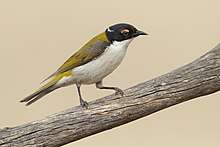White-naped honeyeater
The white-naped honeyeater (Melithreptus lunatus) is a passerine bird of the honeyeater family Meliphagidae native to eastern Australia. Birds from southwestern Australia have been shown to be a distinct species, Gilbert's honeyeater, and the eastern birds are more closely related to the black-headed honeyeater of Tasmania. One of several similar species of black-headed honeyeaters in the genus Melithreptus, it dwells in dry sclerophyll eucalypt woodland. Its diet consists of nectar from various flowers, and it also feeds on insects.
| White-naped honeyeater | |
|---|---|
 | |
| Scientific classification | |
| Kingdom: | Animalia |
| Phylum: | Chordata |
| Class: | Aves |
| Order: | Passeriformes |
| Family: | Meliphagidae |
| Genus: | Melithreptus |
| Species: | M. lunatus |
| Binomial name | |
| Melithreptus lunatus (Vieillot, 1802) | |
Taxonomy
The white-naped honeyeater was originally described as Certhia lunata by French ornithologist Louis Jean Pierre Vieillot in 1802.[2] The specific epithet is derived from the Latin luna, meaning 'moon'; this refers to the crescent-shaped, white marking on its nape. It is a member of the genus Melithreptus, with several species of similar size and (apart from the brown-headed honeyeater) black-headed appearance, in the honeyeater family, Meliphagidae. The next closest relative outside the genus is the much larger, but similarly marked, blue-faced honeyeater.[3] More recently, DNA analysis has shown honeyeaters to be related to the Pardalotidae (pardalotes), Acanthizidae (Australian warblers, scrubwrens, thornbills, etc.), and the Maluridae (Australian fairy-wrens) in the large superfamily Meliphagoidea.[4]
Gilbert's honeyeater, found in southwest Western Australia, was initially described as a separate species by John Gould in 1844,[5] before being reclassified as a subspecies of the white-naped for many years. However, a molecular study published in 2010 showed that it had diverged before the split of populations in eastern Australia into the white-naped and black-headed honeyeaters.[6]
Description
A mid-sized honeyeater at 13–15 cm (5–6 in) in length, it is olive-green above and white below, with a black head, nape and throat, a red patch over the eye, and a white crescent-shaped patch on the nape. It is thinner than other similar species. Juveniles have brownish crowns and an orange base of the bill. Its call is a mjerp mjerp.[7]
Ecology
It is found in eucalypt forest and woodlands. Its diet is principally nectar from a variety of flowers, supplemented by insects and various other invertebrates.
Breeding
White-naped honeyeaters may nest from July to December, breeding once or twice during this time. The nest is a thick-walled bowl of grasses and bits of bark in the fork of a tall tree, usually a eucalypt. Two or three eggs are laid, 18 x 14 mm in size, and shiny, buff-pink, sparsely spotted with red-brown.[8]
References
- BirdLife International (2012). "Melithreptus lunatus". IUCN Red List of Threatened Species. 2012. Retrieved 26 November 2013.CS1 maint: ref=harv (link)
- Vieillot, L.P. (1802). Oiseaux dorés au a reflets metalliques. (published in 32 parts). Paris Vol. 2 [95].
- Driskell, A.C.; Christidis, L (2004). "Phylogeny and evolution of the Australo-Papuan honeyeaters (Passeriformes, Meliphagidae)". Molecular Phylogenetics and Evolution. 31 (3): 943–960. doi:10.1016/j.ympev.2003.10.017. PMID 15120392.
- Barker, F.K.; Cibois, A.; Schikler, P.; Feinstein, J.; Cracraft, J (2004). "Phylogeny and diversification of the largest avian radiation". Proc. Natl. Acad. Sci. USA. 101 (30): 11040–11045. doi:10.1073/pnas.0401892101. PMC 503738. PMID 15263073.
- Gould, J. (1848). The Birds of Australia. 104 pls. London: J. Gould Vol. 4 [pl. 73].
- Toon A, Hughes JM, Joseph L (2010). "Multilocus analysis of honeyeaters (Aves: Meliphagidae) highlights spatio-temporal heterogeneity in the influence of biogeographic barriers in the Australian monsoonal zone". Molecular Ecology. 19 (14): 2980–94. doi:10.1111/j.1365-294X.2010.04730.x. PMID 20609078.
- Simpson K, Day N, Trusler P (1993). Field Guide to the Birds of Australia. Ringwood, Victoria: Viking O'Neil. p. 392. ISBN 0-670-90478-3.
- Beruldsen, G (2003). Australian Birds: Their Nests and Eggs. Kenmore Hills, Qld: self. pp. 314–316. ISBN 0-646-42798-9.
